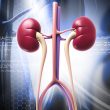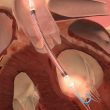iFR has been validated as a useful tool for intermediate lesion analysis, with the advantage of not requiring the use of drugs. On the other hand, its use for PCI outcome assessment has not yet been thoroughly looked into, even though there have been promising data. 24% of DEFINE PCI cases presented ≤0.89 iFR with...
Can Ultrasound Treat Aortic Stenosis?
Severe calcified aortic stenosis is a common condition that can currently be effectively treated with SAVR or TAVR. However, some patients, given comorbidities or anatomical characteristics, are not good candidates for these therapeutic alternatives. The non-invasive ultrasound therapy (NIUT) has surged as viable alternative. It claims ultrasound might act on calcified valves, and mobilize tissue...
Is AS Only Important When Severe?
Aortic stenosis (AS) is a progressive disease associated with morbidity and mortality, especially in severe cases. However, recent studies have revealed that moderate stenosis can also have unfavorable consequences in the course of the disease. One of the challenges lies in that determining its severity is sometimes difficult due to discrepancies between valve area, gradient,...
Low Gradient, Normal Flow Aortic Stenosis: Changes in Quality of Life with TAVR
There is no question as regards the recommended treatment for symptomatic severe aortic stenosis, seeing as both transcatheter and surgical aortic valve replacement (TAVR and SAVR) have shown to significantly improve prognosis. This is despite the fact that there is still certain ambiguity around its characterization, which looks to define it according to hemodynamic severity...
Is Coronary Lithotripsy as Effective as Rotational Atherectomy?
Severely calcified lesions currently pose a significant challenge, as they require adequate preparation through non-compliant balloons or cutting balloons to achieve effective stent expansion. Another option is the use of orbital or rotational atherectomy (RA), but this carries the risk of complications such as slow/no reflow, perforations, dissections, peri-procedural infarction, or guidewire rupture. Despite the...
CAPTIS, a Novel Cerebral Embolic Protection System in TAVR
The incidence of stroke after TAVR ranges between 2 and 5%, depending on the series, which has been associated with higher morbimortality, affecting patient quality of life and their psycho-social environment. Many cerebral embolic protection systems have been developed in response, and even though they have been shown beneficial in many studies, their role in...
Cerebral Embolic Protection Devices: How Useful are they in TAVR?
During TAVR, we often fear the possibility of a stroke, which occurs in approximately 1 – 2% of cases. In general, this phenomenon is caused by thrombi stemming from atherosclerotic or calcified plaque, depending on the etiology. Even though its incidence has declined with technology development and the increasing expertise of operators, it is still...
Is TAVR Beneficial in Cardiogenic Shock?
The presence of cardiogenic shock (CS) in a setting of aortic stenosis ranges from 1% to 4%. The prognosis for this scenario is ominous due to subendocardial ischemia, which presents as a decrease in ventricular preload and an increase in afterload. Aortic valvuloplasty has been used in this context, but, unfortunately, it has been associated...
Renal Denervation is Safe and Reduces Blood Pressure and Medication
We are well aware of the multifactorial nature of hypertension, as well as the fact that it responds well to medication and lifestyle changes. It can be treated with renal denervation (RDN), which has been shown safe and effective in several randomized and non-randomized studies. However, the group of patients that will benefit most from...
Impella in High Risk Coronary Angioplasty before TAVR
The population is aging, which is closely related with the presence of aortic stenosis. This condition, as we know, is associated with coronary artery disease (CAD) approximately in 50% of cases. In high risk surgical patients, this calls for procedures such as percutaneous coronary intervention (PCI) and transcatheter aortic valve replacement (TAVR). PCI with ventricular...









